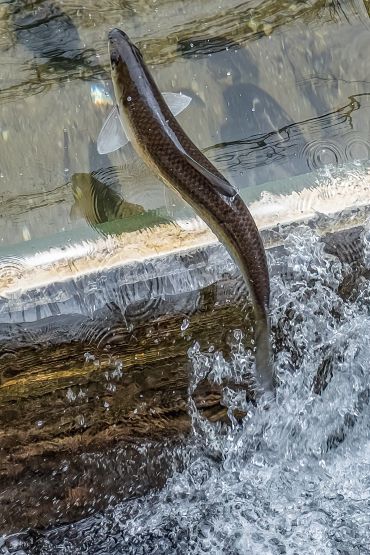Herring Run Program
- Home
- /
- Our Work
- /
- Science
- /
- Community Science
- /
- Herring Run Program
The Importance of River Herring
River herring (alewife and blueback herring) are keystone species in the Atlantic coastal ecosystem. These forage fish sustain a rich food web, nourishing predators such as striped bass, ospreys, seals, and dolphins. Their annual spawning migrations transport vital nutrients from the ocean into freshwater systems, enriching these ecosystems and supporting aquatic life.
Beyond their ecological importance, river herring have deep cultural and economic significance for coastal communities. For centuries, these fish have sustained local fisheries and provided a valuable food source. Their runs are often tied to community events and traditional practices.
River herring are an indicator of the health of the coastal ecosystem—their well-being reflects the overall state of the environment. Declines in river herring populations can signal watershed problems, such as altered hydrology and water quality. Their disappearance disrupts the delicate balance of the food web, impacting predator populations and potentially leading to cascading effects throughout the marine environment.
The Problem

River herring making its way over the weirs on a local Cape Cod fish ladder. Photo credit: G. Beetham
Today, river herring populations are significantly depleted due to a range of human-caused impacts. Overfishing has decimated their numbers. The construction of dams across rivers and other barriers to fish passage have blocked migratory routes to spawning grounds and led to habitat loss. More recently, the escalating impacts of climate change have led to rising water temperatures and disrupted natural cycles that increasingly jeopardize the survival and reproduction of river herring.
Recognizing the critical state of river herring populations, the Massachusetts Division of Marine Fisheries (DMF) placed a moratorium on the taking of river herring across the state in 2005. While recent assessments suggest some stabilization in regional populations, the long-term outlook for river herring remains uncertain. Their recovery will require a multifaceted approach that addresses the underlying threats. This includes restoring river connectivity to improve fish passage, mitigating the impacts of climate change, and limiting their unintended capture, or bycatch, in offshore fisheries.
Monitoring Programs
River herring monitoring programs on Cape Cod are vital for understanding and protecting these ecologically important fish. Often involving dedicated volunteers, these programs track the annual migration of alewife and blueback herring from the ocean to freshwater ponds for spawning. By collecting data on the number of fish passing into local ponds, we gain insights into population trends, identify potential threats, and inform conservation efforts. These data are essential for evaluating the success of restoration projects, which aim to improve river herring access to their spawning grounds, such as dam removal, culvert replacements, and other fish passage improvements. Through these collaborative monitoring efforts, scientists and community members work together to ensure the long-term health and abundance of river herring.

Conducting river herring count monitoring at the Mashpee River.
On Cape Cod, there are a variety of methods used to count river herring. Trained volunteers observe and record fish passing through fish ladders and weirs, providing valuable visual data on relative run size. Electronic counters offer continuous monitoring of fish migrations, which is especially useful for recording nighttime migrations. However, electronic counters are expensive and challenging to maintain. Additionally, advanced technology, such as underwater cameras combined with artificial intelligence, can identify fish species and analyze their behavior, reducing the need for extensive manual observation and increasing the amount of information gathered. While these new technologies are helpful, for the near future, visual counts remain a cost-effective and easily accessible method for monitoring river herring populations.
Before 2007, herring monitoring programs were limited to a few locations on Cape Cod, including the Marstons Mills River, the Coonamessett River, and the Trunk River. Recognizing the importance of these programs, the Association to Preserve Cape Cod (APCC) began working with local communities and agencies in 2007 to expand monitoring efforts. APCC staff actively support these initiatives by providing training, technical assistance, and equipment to partner organizations and town natural resource departments. In 2011, this collaborative effort gained significant momentum with increased support from state and federal agencies, including the National Oceanic and Atmospheric Administration (NOAA) and DMF, along with the Mass Bays Program. This concerted effort aims to foster the restoration and protection of river herring and their habitats.
APCC maintains a valuable time series of river herring visual count data collected from runs across Cape Cod. This dataset, gathered through the efforts of volunteer observers and our partner groups, is crucial for understanding population trends, assessing the effectiveness of restoration efforts, and guiding management decisions to ensure the long-term health of river herring populations and the ecosystems they support. For more information on APCC’s Volunteer River Herring Monitoring Program, contact APCC restoration ecologist, Mike Palmer at mpalmer@apcc.org.
Partnerships
APCC partners with many organizations, towns, agencies, and individuals to promote river herring monitoring, protection, and management. Their dedicated work is the reason why the Cape has the greatest number of active volunteer herring counting groups in Massachusetts. Our partners include:
Organizations/Groups
- Bass River Rod & Gun Club, Yarmouth
- Barnstable Clean Water Coalition, Barnstable
- Cape Cod Salties
- Cedar Lake Herring Monitors, Falmouth
- Cape Cod Conservation District
- Coonamessett River Trust, Falmouth
- Dennis Conservation Land Trust, Dennis
- Eastham Herring Monitors, Eastham
- Friends of Herring River, Wellfleet
- Harwich Conservation Trust, Harwich
- Mashpee Herring Monitors, Mashpee
- Orleans Shellfish and Waterways Advisory Committee, Orleans
- Red Lily Pond Project, Barnstable
- River Herring Network
- Sandwich Herring Monitors, Sandwich
- Stony Brook Herring Monitors, Brewster
Towns
Barnstable, Bourne, Brewster, Dennis, Eastham, Falmouth, Harwich, Orleans, Mashpee, Sandwich, Wellfleet, and Yarmouth.
Agencies
Cape Cod Cooperative Extension, Marine Program
Massachusetts Bays National Estuary Partnership
Massachusetts Division of Marine Fisheries
NOAA Restoration Center
